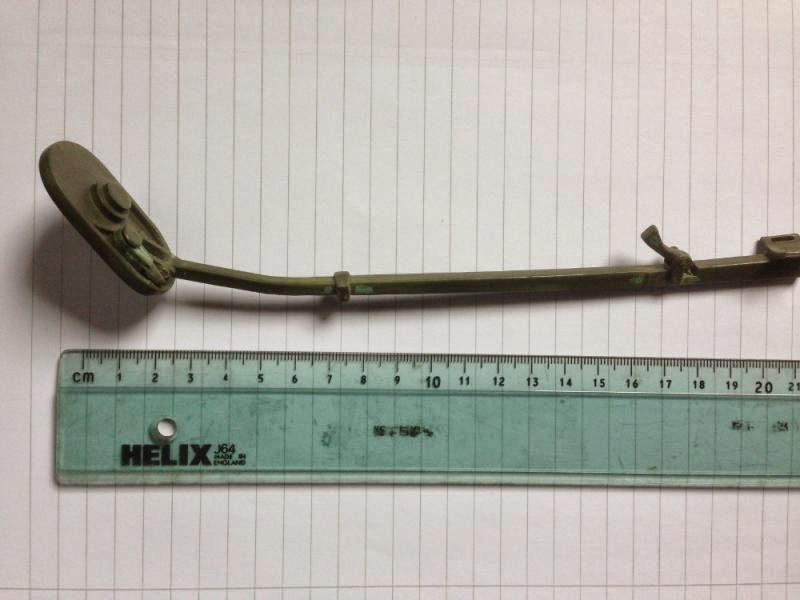Back in the days of Action Man and Tommy Gun the standard British rifle was a modified version of the Belgian FN FAL, a 7.62mm automatic rifle with a 20 round magazine. It was a long weapon with a wooden butt and fore grip, a flip-up rear sight and a folding carry handle. When the Ministry of Defence got them they made numerous small changes to the FN, including removing the ability to be fully automatic, rendering it semi-automatic. The resultant weapon was known as the L1A1 Self Loading Rifle... or just SLR as it became known.
By the 1970s the wooden parts had been replaced by pebble-texture plastic and the carry handle grip had been redesigned.
The rifle soldiered on until the end of the Cold War, some being seen in Kuwait during the first Gulf War in 1991. This elegant rifle has now passed into history, like the era in which it was used. However, it's 1/6 scale offspring are still around.
The first SLR in the scale was the one supplied in several Tommy Gunn sets, which was later copied and used for Action Man's British soldiers. While it looked like the ubiquitous rifle, it was of course simplified, the carry handle was moulded closed down and the barrel was shorter and chunkier than it should be.
The rifle was moulded in brown as a single piece of plastic and painted with black details. A green elastic sling completed the item. Below is an Action Man version, but the Tommy Gunn one was identical.
As the Action Man line carried on into the '70s and '80s the SLR went with him, carried proudly by soldiers in what could only be called military-looking uniforms. By the end of the run the toy had two large lugs fitted so that the holes in a piece of rubber could represent the sling.
And that was that.
In the 1990s 21st Century Toys started to produce 1/6 military figures, almost all of which were US subjects. By today's standards they were crude and clunky, using plastic and elastic to represent webbing and pouches. They were followed by the Chinese model company Dragon Models, who brought out a range of figures far superior in both the figure itself and the clothing/equipment. As the range increased (with every variation of WW2 German soldiers) they expanded into modern figures... and eventually to the British.
In 2002 they produced a Falklands War paratrooper armed with a vast amount of equipment... and an SLR!
This was a thing of beauty... folding carrying handle, removable magazine, web sling with adjusters, and a thin barrel of the correct length. Details were spot on and it looked right.
At the same time a UK based one sixth scale forum produced a limited edition British soldier from the Falklands War, again armed with an SLR. I can't remember if this was metal or resin.
A third source of SLRs came charging in from the Far East, this time a Hong Kong based company called RMC, or Realistic Models Corp. They offered a set of TWO SLRs, one later all-plastic version, and the earlier wooden-parts version. These topped the Dragon one for detail and accuracy, and are now the most sought-after SLRs on the collector's market. They came with several magazines, different sights and scopes, and two bayonets with scabbards.
Barrack Sergeant, also in Hong Kong offered the same RMC SLRs with their Falklands sets. (I'm lucky enough to have two of the Dragon versions and one RMC one... I lost the other somehow.)
In 2012 Dragon brought out a new selection of Falklands War figures, only one being armed with an SLR (the others having the Stirling SMG, GPMG, US M16 rifle and a sniper rifle), which is also now hard to find at a reasonable price.
Back to the very first one and it seems that Tommy Gunn's original weapon is still around. Furuta of Japan has produced a series of 1/6 scale weapons in blind boxes. One of these is an FN FAL.
This, while not an exact replica of the Tommy Gunn and Action Man version was clearly based on it, and has itself been copied and sold in some spy and agent sets from China.
The Furuta version differs from the older one in having an even shorter barrel (cast in metal), a SECOND carry handle in addition to the folded one, a removable magazine and a sticking-up rear sight. The trigger guard is thinner, but the grip is the same, as are the butt and fore grip. It even omits the ejector port.
Below is the Furuta with the Action Man version for comparison.
And this is the gun taken apart (second grip broke off... oops)
Sideshow released a GI Movie figure armed with what appeared to be either an SLR or FN FAL, modified with a shorter barrel and strangely shaped butt... this photo from eBay shows the weapon.
Finally I thought I would show a proper SLR with the Furuta and Action Man versions... just to show how things have changed over the decades... and how the demands for accuracy have changed. The Blank Firing Attachment on my RMC SLR is scratchbuilt, and I am in the process of repainting the wooden parts for more realism.






















.jpeg)
.jpeg)
.jpeg)

.jpeg)

.jpeg)






.jpeg)
.jpeg)
.jpeg)
